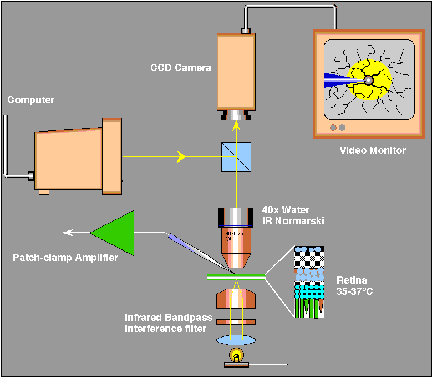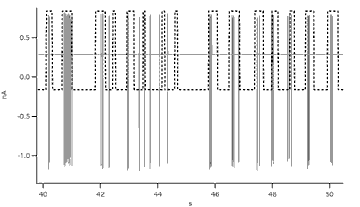Reed College thesis (2004) by Owen Gross (a collaborative project with Dr. Rowland Taylor):
Biophysical Mechanisms of Spike Generation in Direction SelectiveGanglion Cells
A Thesis
Presented to
The Division of Mathematics and Natural Sciences
Reed College
In Partial Fulfillment
of the Requirements for the Degree
Bachelor of Arts
Abstract: First-order Wiener kernels are calculated
from extracellular and intracellular recordings of Direction Selective (DS)
ganglion cells and
used to predict spike bursts, which are compared to spiketrain predictions
from a HodgkinHuxley (HH) like model [T. F. Weiss, Cellular Biophysics Vol.
2 (MIT Press, Cambridge, MA, 1996)] of the cells created in Mathematica.
A reverse correlation method is used to calculate the kernels [P. Dayan and
L. Abbot, Theoretical Neuroscience (MIT Press, Cambridge, MA, 2001)], which
are convolved with the stimulus to estimate the response. Approximately 75%
to 85% of the bursts can be predicted using this method, as demonstrated
in Chapter 5.
The HH spike-train predictions are generated by transforming the stimulus
into a membrane current. This method is motivated by the hypothesis that
the DS cells respond linearly to stimulus velocities. The HH predictions
are generally less successful than the kernel generated burst predictions.
The model remains to be improved through the optimization of the method of
stimulus transformation and the electrical parameters used in solving the
HH equations.
The stimulus consists of an edge between a dark side and a bright side of
a computer monitor that moves with random velocities along the axis parallel
to the DS cell’s preferred direction to stimulate the neurons. This
stimulus was devised as a likely candidate to generate a high signaltonoise
ratio. Unforeseen problems arise, however, due to the temporal autocorrelations
of the edge.
 Illustration of experimental setup. A beam splitter is used to view the cell and electrode through a light microscope (40x magnification) while the stimulus is being presented. Infrared light is used to avoid overexposing the photoreceptors. The CCD is necessarily chosen to be particularly sensitive. Graphic adapted from < http://jcsmr.anu.edu.au/dns/rowland/Set-up.html>. Visit the Taylor Lab. |
 Prediction of spike bursts with actual spike train recorded for trial 242. The bold, dashed line is the spike burst prediction, and the lighter line is the actual record. The spike bursts were predicted by applying a threshold to the the neural response estimate. The kernel used was calculated with data averaged from other runs, so the dashed line is actually a prediction rather than a recreation. Note that most spikes correspond to a predicted burst, and vice versa. |